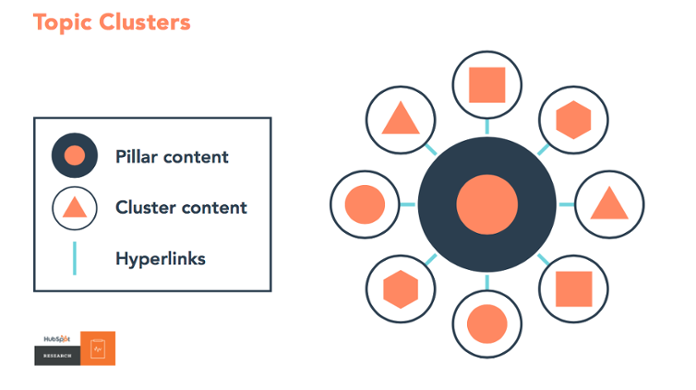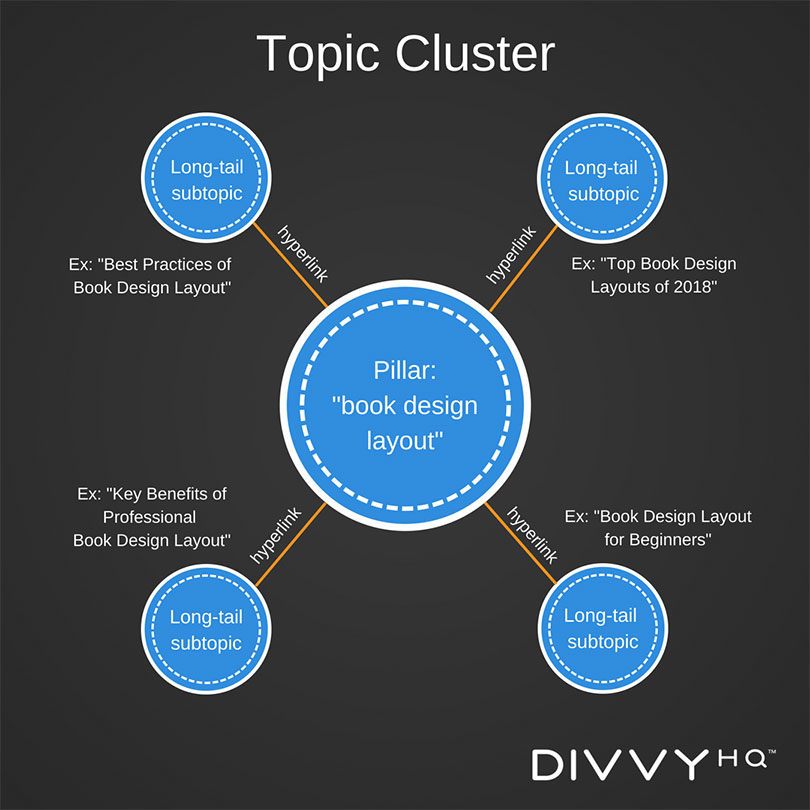SEO specialists and content managers have always struggled with finding a good balance of optimization and quality in their content. Planning a content calendar for several weeks or months in advance can be stressful, especially when you consider the rate at which trends change.
This is why popular search engines such as Google and Bing have started evolving beyond simple keyword algorithms. Topic clustering has become the new norm for reaching higher traffic and visibility while still maintaining a reputable content strategy. But what exactly is topic clustering and how can you adapt your own content planning process to this new SEO technology?

Image credit: Hubspot
Benefits of Topic Clustering
To better understand what a topic cluster is in reality, all we have to do is define the word “cluster”. It represents a group of very similar items that can easily be fitted into the same category, like with a common topic.
Topics of five different articles that analyze the same item (like graphic design for example) represent a cluster of topics. By defining your topics as a cluster, you can effectively connect them with one another and reach better visibility via search engines. According to HubSpot’s recent research, tightly connected content means more hits and subsequent traffic. Some of the most notable benefits of clustering your topics are:
- Interlinking articles and posts that belong in the same cluster improves SEO and offers additional value for readers.
- Creating a topic cluster shows the public that you are ready to commit to a certain niche and analyze it long-term. This can create strong incentive for subscription and bookmarking, both of which are important achievements.
- Clustering topics can help you sell products or services connected to that content. This means that you can comfortably blog about your resume writing services and link that content to actual products on your site.
- Topic clustering increases the SERP ranking of every piece of content belonging to that cluster. SEO has evolved to a point where the same site can show up multiple times in the search results thanks to effective topic clustering.
How Do We Implement It?
So how do we effectively implement topic clustering? How can we change our content planning to reflect this sudden shift in trends and still maintain our revenue and reputation?
1. Define your topics
Luckily for many site administrators and content creators, the process of creating new content isn’t going to change. The way we define the topics to talk about in the near future however, will. For example, if your content strategy and business objectives dictate that you create content surrounding the practice of graphic design, you can set the topic of your cluster to a popular, related term that your prospects are familiar with and likely to search.
For the sake of argument, let’s say that “book design layout” is a good topic that aligns with our service offering and is a popular search phrase. We would start by creating a “pillar page” that acts as the hub of your topic cluster.

Every article that follows in the next content creation cycle should be connected to that topic, both in wording and content. Defining the topics for your particular blog should be easy enough. All you have to do is decide on what topics align with your content strategy, are trendy in your niche and follow that topic to wherever it leads you. Your blog’s structure should be split into pillars, each containing the respective cluster of articles that belong to it. Let’s take a look at a simple example:
- Book design layout (main topic) – Article – Article – Article – Article
- Poster design (main topic) – Article – Article – Article – Article
As you can see, each successive article or piece of content follows the topic set by the pillar page. The entire point of implementing topic clustering is to “cluster” content together so that it makes sense as a group. Your readers will have an easier time browsing and digesting your content if you embrace the topic clustering content planning approach.
2. Create striking headlines
This is where things get interesting when topic clustering is concerned. Content planning through topic clustering doesn’t take keywords into consideration. Should you decide to embrace clustering as your go-to method of content planning, your attention should be directed at the headlines.
Be that as it may, keywords still matter in SEO optimization and will continue to do so. However, they take a backseat when it comes to headlines in a topic cluster. Remember the main topic of “book design layout” we set earlier as an example? Let’s see how creating actual article topics looks like with this example in mind:
- Book design layout principles and examples
- Top book design layouts by professional designers
- Book design layout benefits and key factors to consider
As you can see, the headlines of your articles should contain the exact topic you have set for your cluster. You can create any combination of words and phrases as long as the topic cluster is intact. This helps people that search for relevant content in descriptive sentences.
Not everyone will search for book design principles – some people will ask their search engine a direct question. People usually do this through voice search features and personal companion apps such as Cortana or Bixby. The gist of it is that your headlines should follow the pattern set by your initial topic and the cluster will be defined successfully.
3. Refine your topic cluster
As far as content planning and calendars go, topic clustering isn’t open to improvisation mid-cycle. Once you commit to a topic cluster, you should see it through and then define new topics that your content creators will tackle.
However, this can prove highly beneficial to you since you will easily see which topics work with your audience and which ones simply don’t. Sticking to the graphic design example we used earlier, if “blue” doesn’t work, why not try “red” or “green”?
Don’t settle for a plan that doesn’t turn out to be what you thought it would be and don’t be afraid to redefine your topic cluster in your next content planning cycle. Once you get into the groove of creating attractive topics for your followers, it will only be a matter of repeating the same process for each cycle.
Don’t Follow Trends – Set Them
Lastly, when it comes to topic clustering and the impact it has on SEO – don’t follow examples of others. What works for one site might not work on the other, so be your own content compass in this uncharted sea.
Topic clustering is a relatively young method of planning and creating content, which means there are no rules set in stone. Give yourself the freedom to experiment, pioneer certain trends and set examples that others may follow in the future. Only then will you be able to truly redefine the way you share content with others online.